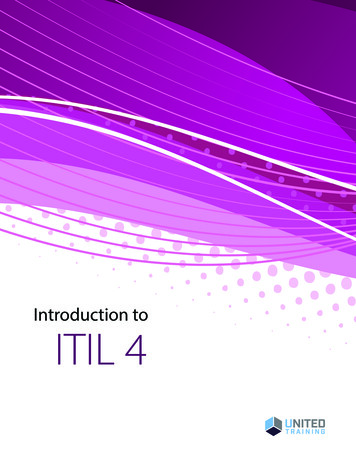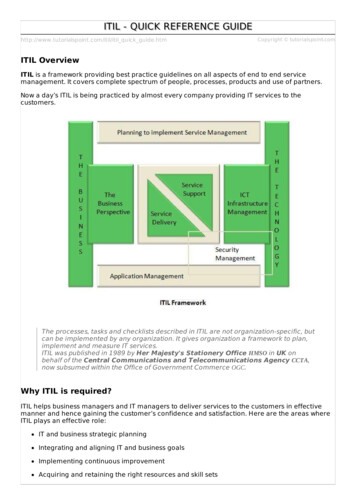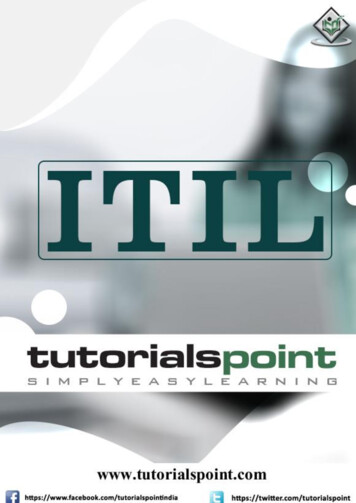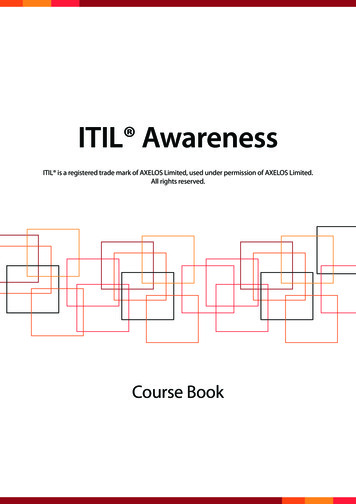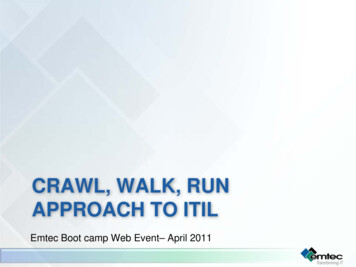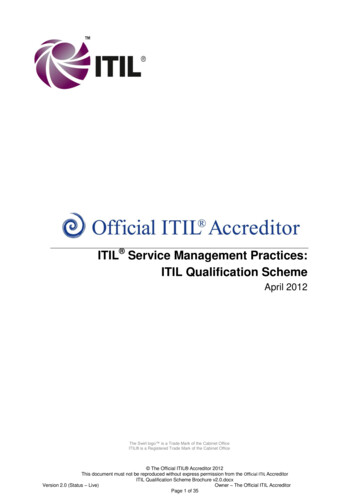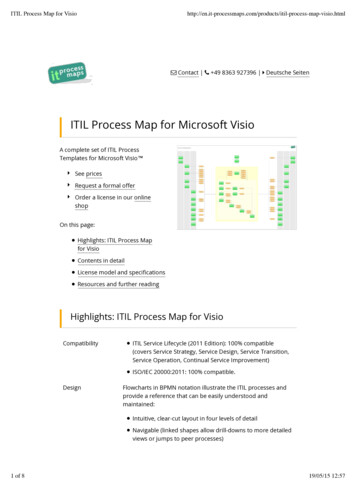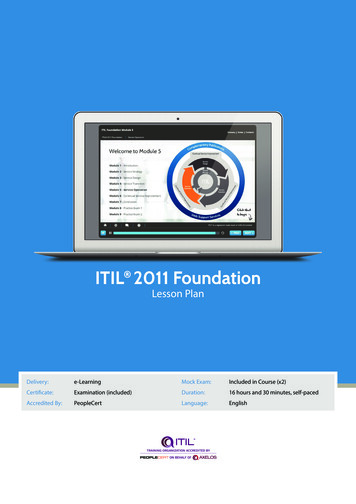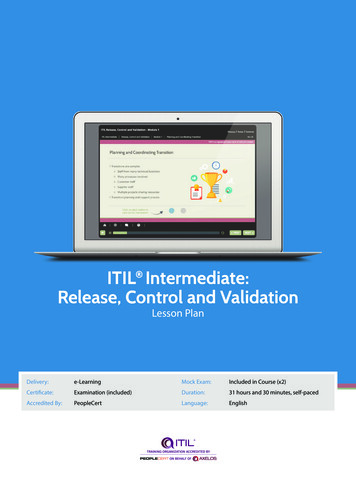
Transcription
ITIL Intermediate:Release, Control and ValidationLesson PlanDelivery:e-LearningMock Exam:Included in Course (x2)Certificate:Examination (included)Duration:31 hours and 30 minutes, self-pacedAccredited By:PeopleCertLanguage:English
ITIL Intermediate: Release, Control and Validation - Lesson PlanThis Lesson PlanContentsThis lesson plan provides you with all the informationabout the Good e-Learning ITIL Release, Control andValidation e-learning course. Before you begin yourstudies, please read through this document to help youplan your studying and revision activities.Welcome3Prerequisites3Who will Benefit from this Course?3Course Materials3Exercises/Personal Revision4Quizzes4Mock Exams4Taking the ITIL Release, Control and Validation Exam4How to Book an Exam4Technical SupportHow to Take the Exam4UK 44(0) 8435 235 096USA 1(917) 472-9842support@goodelearning.comWhat does the ITIL Release, Control and ValidationExam Consist of?4How to Get Help from our ITIL Trainer and Mentor4Detailed Lesson Plan5 Module 1: Introduction to Release, Control andValidation5Good luck!Tutor SupportContact your tutor at any point during the course onitil-tutor@goodelearning.comModule 2: Change Management Module 3: Service Asset and ConfigurationManagement7Module 4: Service Validation and Testing8Module 5: Release and Deployment Management9Module 6: Request Fulfilment10Module 7: Change Evaluation11Module 8: Knowledge Management12Module 9: RCV Roles and Responsibilities13 Module 10: Technology and ImplementationConsiderations14Module 11: Exam PreparationITIL Terminology Copyright 2015 Good e-Learning, all rights reserved. This e-Learning course is delivered by Good e-Learning, and accredited by PeopleCert.No part of this publication may be reproduced, resold, stored in a retrieval system, or distributed in any form or by any means, without the prior permission of the copyright owner.Such requests for permission may be submitted to: marketing@goodelearning.com. Good e-Learning is a trading name used by Educational Systems Ltd.ITIL is a Registered Trademark of AXELOS Ltd.614152
ITIL Intermediate: Release, Control and Validation - Lesson PlanWelcomeWelcome to the Good e-Learning ITIL Release, Controland Validation Certification course.The ITIL Release, Control and Validation qualificationis one of four ITIL Service Capability Courses and willprovide you with guidance that focuses on the practicalapplication of RCV practices in order to enable change,service asset and configuration, release and deploymentand knowledge management, request fulfilment andservice validation and testing.This is an accredited, interactive e-Learning course forstudents who wish to become certified in ITIL Release,Control and Validation. As well as in-depth visual learningcontent, the online course contains audio and videonarratives, quizzes and practice exams.There are 2 objectives of this course. The first is to gainan introductory overview of the Service managementlifecycle, its key processes, roles etc. You also want topass the exam! It is the aim of the course to satisfy both. The course contains a number of videos, with avoiceover commentary. You may stop and start the course whenever you like. Do not try and cover too much material at once; abenefit of e-learning is that you can take your time. Use the quizzes to check that you have understoodthe previous session. Where you have answeredincorrectly, read the guidance, and then review thattopic again. Use the exercises to further consolidate yourlearning. Remember, this course is not just aboutpassing an exam; it is to give you an awareness ofthe importance of IT Service Management in real-life. The Case Study slides show you how the frameworkmight be used in a fictional organization. Remember you can ask the tutor at any time, and willreceive an email reply within 24 hours.PrerequisitesThis course is part of a range of ITIL Intermediate LevelQualifications. Before taking this course you must havesuccessfully completed and passed one of the followingfoundation level qualifications: ITIL v3 or 2011 Foundation, or ITIL v2 Foundation and v2/v3 Foundation Bridge. The ITIL Release, Control and Validation Certificateis part of the ITIL Intermediate capability stream,and one of the modules that leads to the ITIL ExpertCertificate in IT Service Management.ITIL MasterITIL ExpertManaging Across the LifecycleSS SD ST SO CSIOSA PPO RCV SOAIntermediate LifecycleIntermediate CapabilityITIL Foundation Crown Copyright 2011. Reproduced with permission from Axelos LtdWho will Benefit from this Course?This course will be of benefit to any IT professionalwho needs to understand the concepts and activitiesof ITIL Release, Control and Validation at managementlevel. It will also benefit but is not restricted to ReleaseManagers, Security Administrators, IT OperationsManagers, Database Administrators and SecurityManagers who wish to understand how to apply RCVpractices in support of the service management lifecycle.It is also suitable if you have completed the ITILFoundation certificate, and you are wishing to advance tohigher level ITIL certifications.Course MaterialsWhen you log in to the course you will have access to thefollowing learning materials.A series of interactive tutorials that cover the followingtopics: Introduction to Release, Control and Validation Change Management Service Asset and Configuration Management Service Validation and Testing Release and Deployment Management Request Fulfilment Change Evaluation Knowledge Management RCV Roles and Responsibilities Technology and Implementation Considerations Exam Preparation Copyright 2015 Good e-Learning, all rights reserved. This e-Learning course is delivered by Good e-Learning, and accredited by PeopleCert.No part of this publication may be reproduced, resold, stored in a retrieval system, or distributed in any form or by any means, without the prior permission of the copyright owner.Such requests for permission may be submitted to: marketing@goodelearning.com. Good e-Learning is a trading name used by Educational Systems Ltd.ITIL is a Registered Trademark of AXELOS Ltd.3
ITIL Intermediate: Release, Control and Validation - Lesson PlanExercises/Personal RevisionHow to Book an ExamThere are a number of exercises which can be used forpersonal revision, to consolidate learning. They also helpto break up the videos.You can book a PeopleCert exam via the PeopleCert website.You will first need to create an account by filling in yourpersonal details.QuizzesEvery module ends with a number of multiple choicequiz questions. These match, as far as is possible, theformat of the official exam, and are intended to beequally challenging. By having these quiz sessions aftereach module, you will gain confidence that you aremeeting the learning objectives of this qualification.Additionally, the course contains the following: Exercises in a downloadable exercise booklet, tofurther consolidate your learning. Suggested answers to the exercises in adownloadable booklet. A downloadable copy of the official Acronymsdocument. A downloadable copy of the official Glossary which isalso available online throughout the course. Two official Mock exams, with answers A number of additional downloadable resourceswhich concentrate on a key concept or process.In order to book your exam, you will need an ExamVoucher. If you purchased this with your course,when you think you are ready to book, please contactsupport@goodelearning.com and we will send oneimmediately. The exam voucher is valid for 1 year fromthe date of issue.How to Take the ExamBecause the exam is taken online, you can take it at alocation and time that suits you.Using PeopleCert software, your computer’s webcam andmicrophone records your exam session from start to finish.At the end of the exam, the recorded video and audio isthen sent to PeopleCert, to be reviewed retrospectively by aremote proctor. The proctor will look at the recorded footageto check you have complied with exam guidelines.You will receive the final result within 10 days by e-mail andpost.What does the ITIL Release, Control andValidation Exam Consist of?Mock ExamsThis is a multiple choice exam consisting of eightscenario-based questions.We strongly encourage you to attempt both mock examsas part of your revision. The mock exams are intendedto closely simulate the exam conditions that you will facewhen taking the real thing. Tutor support is available ifyou are struggling to achieve a pass mark.Each question is gradient scored, meaning that you willhave four answer options to choose from, and eachanswer will either be worth five marks, three marks, onemark, or zero marks.Taking the ITIL Release, Control andValidation ExamThe exam is closed book - you cannot make use of anyresources or materials during the exam.Upon completing this course you should be able to preparefor the ITIL Release, Control and Validation Exam. This canbe taken online at a place and time that suits you, usingPeopleCert.PeopleCert is a service that allows you to take yourcertification exam online (virtually) from your own PC orlaptop. If you purchased the course and a voucher for theexam, Good e-Learning will provide the voucher to you onrequest.You will have 90 minutes to complete the exam.There are a maximum of 40 potential marks in this exam;to pass you must get at least 28 out of 40 marks correct(70%).How to Get Help from our ITIL Trainerand MentorFor all enquiries, a qualified ITIL Tutor can always bereached by e-mail (itil-tutor@goodelearning.com) orby clicking a link from the ‘support section’ within thecourse. You will receive a response to your ITIL questionor query within 24 hours.Detailed Lesson PlanThe following tables summarise each of the modules, theirlearning objectives, and the method(s) of delivery. The totalstudying time required for this course is 31 hours, 30 minutes. Copyright 2015 Good e-Learning, all rights reserved. This e-Learning course is delivered by Good e-Learning, and accredited by PeopleCert.No part of this publication may be reproduced, resold, stored in a retrieval system, or distributed in any form or by any means, without the prior permission of the copyright owner.Such requests for permission may be submitted to: marketing@goodelearning.com. Good e-Learning is a trading name used by Educational Systems Ltd.ITIL is a Registered Trademark of AXELOS Ltd.4
ITIL Intermediate: Release, Control and Validation - Lesson PlanModule 1: Introduction to Release, Control and Validation (2 hours)Upon starting Module 1, you will receive detailed instructions for navigating the e-learning course and how to accesssupport for your studies.Session TitleDurationIntroductionLearning ObjectiveDelivery MethodThis module of the course provides an introduction to the purposeand objectives of the service transition phase and the role that RCVplays within that phase and within the service lifecycle.Considerations for developing a transition strategy and planningand coordinating service transition activities are explored, includingassociated roles and responsibilities.To meet the learning outcomes and examination level of difficulty,the candidates must be able to understand and describe: Purpose and objectives of service transition Scope of the service transition phase in relation to the RCVprocesses, its value to the business and how the RCV processesinteract with processes within other lifecycle stages Various aspects to be considered for developing an effectiveservice transition strategy Defining service transition lifecycle stages The key initiatives that are important for an effective preparationfor service transition The approach and best practices in planning and coordinatingservice transition activities How service transition provides transition process support tostakeholdersLesson 1:Introduction to RCV1 hour, 10 minsUnderstand and describe: The purpose, objectives and scope of Service Transition(ST 1.1.1, 1.1.2) Developing a transition strategy (1.1.4) Defining transition lifecycle stages (ST 4.1.5.2) Preparing for Service Transition (ST 4.1.5.3) Planning and coordinating Service Transition activities (ST 4.1.5.4) How Service Transition supports stakeholders (ST 4.1.5.5)Video and VoiceoverExercise40 mins(to include review)Transition strategyTextQuiz8 mins(to include review)5 quiz questions to consolidate learning. Each question has anexplanation provided, and the student may review their answers.Multiple Choice Questions Copyright 2015 Good e-Learning, all rights reserved. This e-Learning course is delivered by Good e-Learning, and accredited by PeopleCert.No part of this publication may be reproduced, resold, stored in a retrieval system, or distributed in any form or by any means, without the prior permission of the copyright owner.Such requests for permission may be submitted to: marketing@goodelearning.com. Good e-Learning is a trading name used by Educational Systems Ltd.ITIL is a Registered Trademark of AXELOS Ltd.5
ITIL Intermediate: Release, Control and Validation - Lesson PlanModule 2: Change Management (4 hours, 30 minutes)Session TitleDurationIntroductionLearning ObjectiveDelivery MethodThis learning unit covers how the process of Change Managementcontributes to RCV practices. The lifecycle stage emphasized in thisunit is service transition A complete overview of the objectives, scopeand importance of Change Management as a process to generatebusiness value are explored and demonstrated using examples.Change Management policies, principles, concepts, design, activities,methods and techniques are explained in relationship to RCVpractices as well as to and especially in relation to types of changerequests and how they flow through the process. Efficient use ofChange Management metrics are reviewed in this unit as well as howservice operation and continual service improvement interacts withchange management.To meet the learning outcomes and examination level of difficulty,the candidates must be able to understand, describe, identify,demonstrate, apply, distinguish, produce, decide or analyse: The purpose and objectives of the Change Managementprocess and describe its practical application within a businessenvironment The scope of the Change Management process The business value of change management and demonstratesome practical examples in real-life situations Change management policies, and its design and planningconsiderations Types of change request, and describe them using examples byservice lifecycle stage; distinguish changes, requests for change(RFCs) and change records The role of change models, change proposals and standardchanges The options and considerations for remediation planning Typical activities involved in managing changes, and describeworkflow of processing different types of change requests The methods and techniques associated with each major changemanagement activity The change management process triggers, inputs, outputs andinterfaces with other processes The role of the configuration management system (CMS) inchange management How change management can be effectively measured, andexamples of critical success factors and key performanceindicators The challenges and risks of change management Typical change management activities that may be performed ona day-to-day basis during the service operation lifecycle stage Managing organization and stakeholder change as an essentialpart of continual improvementLesson 1: ChangeManagementLesson 2: ChangeManagement1 hour(for lessons 1 to 3)Lesson 3: ChangeManagementChange Management’s Purpose, objectives and scope (ST 4.2.1, 4.2.2) Business value (ST 4.2.3) Policies (ST 4.2.4.1) Design and planning considerations (ST 4.2.4.2) Types of change request (ST 4.2.4.3, 4.2.4.4) Change models (ST 4.2.4.5, 4.2.4.6, 4.2.4.7) Remediation planning (ST 4.2.4.8)Video and Voiceover T ypical process activities (ST 4.2.5 up to beginning of 4.2.5.1,including Figures 4.2, 4.3 and 4.4)Methods and techniques (ST 4.2.5)Video and VoiceoverInputs, outputs and triggers (ST 4.2.6)The role of the CMS (ST 4.2.7)Performance management (ST 4.2.8)Challenges and risks (ST 4.2.9)Change in service operation (SO 5.12.1, 8.1) Organisational and stakeholder change (ST 5.2 [up to 5.2.1],ST 5.2.1.1, ST 5.2.3 [up to 5.2.3.1])Video and Voiceover Exercise 140 mins(to include review)The requirements of an ITIL conformant change managementprocessTextExercise 240 mins(to include review)Change Management impact assessmentText Copyright 2015 Good e-Learning, all rights reserved. This e-Learning course is delivered by Good e-Learning, and accredited by PeopleCert.No part of this publication may be reproduced, resold, stored in a retrieval system, or distributed in any form or by any means, without the prior permission of the copyright owner.Such requests for permission may be submitted to: marketing@goodelearning.com. Good e-Learning is a trading name used by Educational Systems Ltd.ITIL is a Registered Trademark of AXELOS Ltd.6
ITIL Intermediate: Release, Control and Validation - Lesson PlanExercise 340 mins(to include review)Change Management information gatheringTextExercise 440 mins(to include review)CAB AgendaTextExercise 540 mins(to include review)Change Management CSFs and KPIsTextQuiz12 mins(to include review)5 quiz questions to consolidate learningMultiple Choice QuestionsModule 3: Service Asset and Configuration Management (3 hours, 30 minutes)Session TitleDurationIntroductionLearning ObjectiveDelivery MethodThis learning unit expands on how the process of service asset andconfiguration management (SACM) contributes to RCV practices.The lifecycle phase emphasized in this unit is service transition. Itprovides a complete overview of the purpose, objectives, scope andimportance of SACM as a process to generate business value SACMpolicies, principles, concepts, activities, methods and techniquesare explained in relation to RCV practices. The importance and useof configuration items (CIs) is explained, along with tools, activitymodels, CMS back-ups and historical data. Efficient use of SACMmetrics are reviewed in this unit, as well as how service operationinteracts with SACM.To achieve the learning outcomes and meet the examination levelof difficulty, the candidates must be able to understand, describe,identify, demonstrate, apply, distinguish, produce, decide or analyse: The purpose and objectives of the SACM process The scope of SACM The business value of the SACM process, and demonstrate somepractical examples in real-life situations SACM policies and basic concepts and various types of CIs The use of a configuration management system (CMS), and itsmajor components, in supporting the effective execution of SACMprocess The activities of asset management, the role of software assetmanagement and associated tools The key SACM process activities and deliverables for executingeach of these activities The SACM process triggers, inputs, outputs and interfaces withother processes The information management considerations for SACM How the SACM process can be effectively measured, andexamples of critical success factors and key performanceindicators and their application The challenges and risks of SACM Typical SACM activities performed on a daily basis by serviceoperationLesson 1: SACM Part 1Lesson 2: SACM Part 22 hours, 40 mins(for lessons 1 to 3)Lesson 3: SACM Part 3Understand, describe and apply the following SACM activities(ST 4.3.5): Management and planning Configuration identification Configuration control Status accounting and reporting Verification and auditVideo and VoiceoverUnderstand, describe and apply the following topics: High level process activities, methods and techniques (SO 4.2.5)Video and VoiceoverUnderstand, describe and apply the following topics Inputs, outputs and triggers (ST 4.3.6) Information management (ST 4.3.7) Performance management (ST 4.3.8) Challenges and risks (ST 4.3.9) SACM in service operation (SO 5.12.2)Video and VoiceoverExercise40 minutes(to include review)Outline plan for the introduction of a service asset and configurationmanagement processTextQuiz12 minutes(to include review)5 quiz questions to consolidate learningMultiple Choice Questions Copyright 2015 Good e-Learning, all rights reserved. This e-Learning course is delivered by Good e-Learning, and accredited by PeopleCert.No part of this publication may be reproduced, resold, stored in a retrieval system, or distributed in any form or by any means, without the prior permission of the copyright owner.Such requests for permission may be submitted to: marketing@goodelearning.com. Good e-Learning is a trading name used by Educational Systems Ltd.ITIL is a Registered Trademark of AXELOS Ltd.7
ITIL Intermediate: Release, Control and Validation - Lesson PlanModule 4: Service Validation and Testing (4 hours)Session TitleDurationIntroductionLearning ObjectiveDelivery MethodThis learning unit introduces the service validation and testing(SVT) process and looks at how it contributes to RCV. It provides acomplete overview of the purpose, objectives, scope and importanceof SVT as a process, the various test models, test and validationconditions. SVT policies, principles, concepts, activities, methods andtechniques are explained in relation to RCV practices and building/achieving quality of service. Efficient use of SVT metrics is reviewedin this unit in terms of business value contribution and internalefficiency.To achieve the learning outcomes and meet the examination levelof difficulty, the candidates must be able to understand, describe,identify, demonstrate, apply, distinguish, produce, decide or analyse: The purpose and objectives of the SVT process The scope of the SVT process The business value of the SVT process, and demonstrate somepractical examples in real-life situations How policies can drive and support the execution of the SVTprocess, and describe practical examples of such policies Various test models, their objectives and test conditions, andexamples of validation conditions Various validation and testing perspectives, their purposes andthe stakeholder groups ’ requirements to be addressed The use of test levels and test models to help with build qualityservice deliverables during the early stage of the servicedevelopment lifecycle The key activities of the SVT process, the underlying method andtechniques in performing each step The SVT process triggers, inputs, outputs and interface with otherprocesses The practices of maintaining test data and test environments inrespect of changing test requirements How the SVT processes can be measured in terms of businessvalue contribution and internal efficiency, and examples of criticalsuccess factors and key performance indicators The challenges and risks of SVTLesson 1: SVT- Part 1Lesson 2: SVT- Part 22 hours, 30 mins(for Lessons 1 and2 together)Understand, describe and apply the following topics: Purpose, objectives and scope ) ST 4.5.1, 4.5.2) Business value (ST 4.5.3) Policies (ST 4.5.4.1) Test models (ST 4.5.4.5, ST Table 4-10) Testing perspectives (ST 4.5.4.6) Levels of testing (ST 4.5.4.7, ST Fig 4-14)Video and VoiceoverUnderstand, describe and apply the following topics: Process activities (ST 4.5.5, ST Fig 4-32) Triggers, inputs and outputs (ST 4.5.6) Interfaces and Information management (ST 4.5.6.4, 4.5.7) CSFs and KPIs (ST 4.5.8) Challenges and risks (ST 4.5.9)Video and VoiceoverExercise 140 mins(to include review)Test ModelsTextExercise 240 mins(to include review)SVT Challenges and RisksTextQuiz12 mins(to include review)5 quiz questions to consolidate learningMultiple Choice Questions Copyright 2015 Good e-Learning, all rights reserved. This e-Learning course is delivered by Good e-Learning, and accredited by PeopleCert.No part of this publication may be reproduced, resold, stored in a retrieval system, or distributed in any form or by any means, without the prior permission of the copyright owner.Such requests for permission may be submitted to: marketing@goodelearning.com. Good e-Learning is a trading name used by Educational Systems Ltd.ITIL is a Registered Trademark of AXELOS Ltd.8
ITIL Intermediate: Release, Control and Validation - Lesson PlanModule 5: Release and Deployment Management (4 hours, 30 mins)Session TitleDurationIntroductionLearning ObjectiveDelivery MethodThis learning unit covers how the release and deploymentmanagement (RDM) process contributes to RCV practices. Itprovides a complete overview of the purpose, objectives, scope andimportance of release and deployment management as a processto generate business value. Release and deployment managementpolicies, principles, concepts, activities, methods and techniques areexplained in relationship to RCV practices. The concept of the releaseunit is explained, along with RDM planning, release build and test,pilots, deployment, logistics, delivery, retirement, risks and financials.Efficient use of RDM critical success factors and key performanceindicators are reviewed.To achieve the learning outcomes and meet the examination levelof difficulty, the candidates must be able to understand, describe,identify, demonstrate, distinguish, decide or analyse: The purpose, and objectives of the RDM process The scope of the RDM process The business value of the RDM process RDM policies, the concept of a release unit, release design optionsand considerations, and models The four phases of RDM Release and deployment planning considerations Release and deployment plans Pass/fail criteria Build and test planning Planning release packaging and build Preparation for release build and test Deployment planning Planning of pilots Financial/commercial planning The key steps and techniques for performing the release buildand test stage Release and build documentation Acquire and test input configuration items and components Build and manage the testLesson 1: RDM Part 1Lesson 2: RDM Part 23 hours, 10 mins(for Lessons 1 to 3)Lesson 2: RDM Part 3Understand, describe and apply the following topics: Purpose, objectives and scope (ST 4.4.1, 4.4.2) Business value (ST 4.4.3) Policies (ST 4.4.4.1) Release units (ST 4.4.4.2) Release design options (ST 4.4.4.3) Release models (ST 4.4.4.4)Video and Voiceover The four phases of RDM (ST 4.4.5 [up to 4.4.5.1])Key process activities: Release and deployment planning (ST 4.4.5.1) Release build and test (ST 4.4.5.2) Deployment (ST 4.4.5.3, ST Fig 4-25) Review and close (ST 4.4.5.4)Video and Voiceover Inputs, outputs and triggers (ST 4.4.6)Information management (ST 4.4.7)Performance management (ST 4.4.8)Challenges and risks (ST 4.4.9)RDM in service operation (SO 5.12.3)Video and VoiceoverExercise 140 mins(to include review)RDM PlanTextQuiz12 mins(to include review)5 quiz questions to consolidate learningMultiple Choice Questions Copyright 2015 Good e-Learning, all rights reserved. This e-Learning course is delivered by Good e-Learning, and accredited by PeopleCert.No part of this publication may be reproduced, resold, stored in a retrieval system, or distributed in any form or by any means, without the prior permission of the copyright owner.Such requests for permission may be submitted to: marketing@goodelearning.com. Good e-Learning is a trading name used by Educational Systems Ltd.ITIL is a Registered Trademark of AXELOS Ltd.9
ITIL Intermediate: Release, Control and Validation - Lesson PlanModule 6: Request Fulfilment (2 hours)Session TitleDurationIntroductionLearning ObjectiveDelivery MethodThis learning unit looks at how the request fulfilment processcontributes to RCV practices. The lifecycle phase emphasized inthis unit is service operation A complete overview of the objectives,scope and importance of request fulfilment as a process as well asof how request fulfilment may help to establish a self-help servicepractice within an organization. Request fulfilment policies, principles,basic concepts, activities, methods and techniques are explained inrelation to RCV practices.The relationship between request fulfilment and release anddeployment management is explored, as well as how it differs fromincident management.To achieve the learning outcomes and meet the examination levelof difficulty, the candidates must be able to understand, describe,identify, demonstrate, distinguish, decide or analyse: The purpose, objectives and scope of the request fulfilmentprocess The business value of the request fulfilment process Request fulfilment policies, principles and basic concepts. Request fulfilment activities and demonstrate some practicalexamples of service requests that can be offered as standardservices by category Request fulfilment process triggers, inputs, outputs and interfaces(particularly with RDM, SACM and change management) Information required by the request fulfilment process How request fulfilment can be effectively measured, andexamples of critical success factors and key performanceindicators Challenges and risks pertaining to request fulfilmentLesson 1: RequestFulfilment Part 1Lesson 2: RequestFulfilment Part 250 mins(for Lessons 1 and2 together)Understand, describe and apply the following topics: Purpose and objectives (SO 4.5.1) Scope (SO 4.5.2) Value to business (SO 4.5.3) Policies, Principles and basic concepts (SO 4.5.4)Video and VoiceoverUnderstand, describe and apply the following topics: Process activities, methods and techniques (SO 4.3.5) Triggers, inputs, outputs and interfaces (SO 4.3.6) Information Management (SO 4.3.7) CSFs and KPIs, challenges and risks (SO 4.3.8, 4.3.9)Video and VoiceoverExercise 120 mins(to include review)Request TypesTextExercise 240 mins(to include review)Request fulfilment interfaces with other processesTextQuiz12 mins(to include review)5 quiz quest
ITIL v2 Foundation and v2/v3 Foundation Bridge. The ITIL Release, Control and Validation Certificate is part of the ITIL Intermediate capability stream, and one of the modules that leads to the ITIL Expert Certificate in IT Service Management. Who will Benefit from this Course? This course will be of benefit to any IT professional


